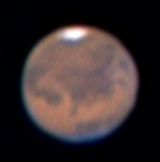
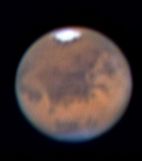
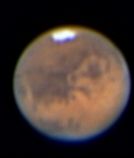
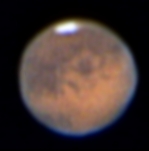
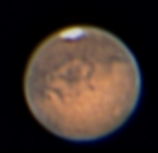
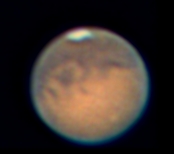
These images show Mars at intervals of approximately one hour apart. Mars rotates on its axis slightly slower than Earth does, requiring 24.6 hours to complete one revolution. During a single night, it is not possible to see the entire surface of the planet. Click here to see an animation of Mars rotating.
The year 2003 provided an exceptional opportunity to observe Mars. Mars was closer to Earth than at any time within the past 59,619 years, according to Sky & Telescope Magazine senior editor Roger Sinnott. Viewed through a telescope, Mars had an apparent size of 25.11 arc-seconds, which is the maximum possible size that Mars can have as seen from Earth. The distance between Earth and Mars at closest approach was 55,758,006 kilometers, or about 34.6 million miles. Mars will not be closer to Earth until August 28, 2287, when the planet will be only 70,000 kilometers nearer.
North is down in these images, and the eastern limb of the planet is to the right. The images were taken from my backyard in Scottsdale, Arizona, using a ToUcam Pro web cam on a Takahashi FCT-150 refractor. Even at its maximum possible size, Mars only has the angular size of a penny seen at a distance of 500 feet. A Televue 4x PowerMate and Vari-Extender were used to increase the focal length to about f45 in order to magnify the image. The images captured with the ToUcam were aligned and stacked with Registax software.
Constellation: Aquarius
RA: 22h 34m 48.4s Dec: -16d 00' 28"
August 31, 2003
Image by Sid Leach
Scottsdale, Arizona
Recent Images.
Complete list of images.
Description of equipment used to acquire images.
Home
Feedback and comments should go to Sid